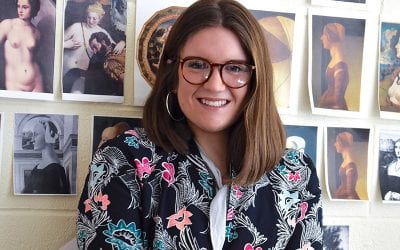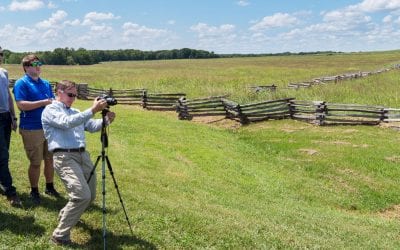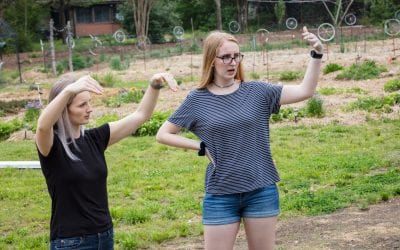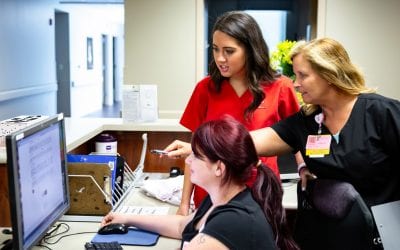
“We definitely leaned on each other, sometimes literally.”
Queens of the Jungle
By Samantha Kirby
Photos courtesy Kelsey Johnson and Mersady Redding
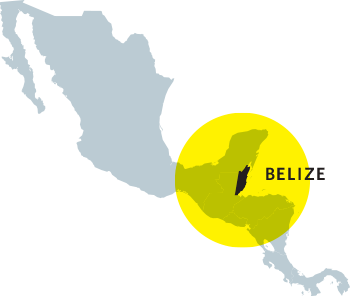 Senior honors students Kelsey Johnson and Mersady Redding were traipsing through the Belizean jungle one day when they heard low grunts nearby. Stooping down, hoping for a sighting of wild pigs, the two women and their three guides suddenly fell victim to an onslaught of sticks hurled at them from above.
Senior honors students Kelsey Johnson and Mersady Redding were traipsing through the Belizean jungle one day when they heard low grunts nearby. Stooping down, hoping for a sighting of wild pigs, the two women and their three guides suddenly fell victim to an onslaught of sticks hurled at them from above.
Black howler monkeys.
“There was a male across the river,” Johnson explains, “and he was screaming and trying to throw things at us because we were right below the female in the trees. He was so mad! But we all started laughing.”
“There’s a reason we call them howler monkeys!” Redding adds.
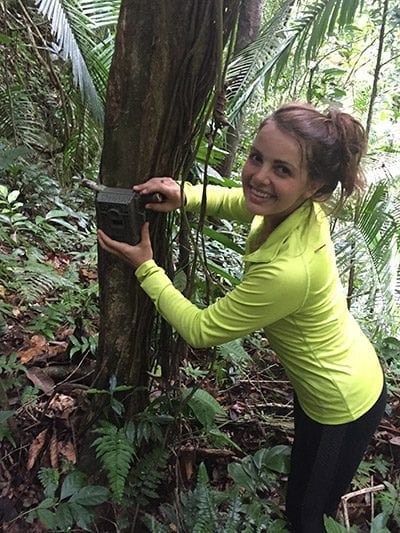
Redding installs a game camera.
This was just another day on the job for the animal science majors, who conducted their honors thesis research last summer in Billy Barquedier National Park, Belize. Their objective was to conduct a survey of mammal species found in the park; a comprehensive list did not exist, and mammal sightings are a major tourist attraction. By the end of their eight weeks in country, the two were able to identify a total of 20 species through direct observation, identification of animal tracks, game cameras and live traps; among these were many mammals that are considered at risk or endangered, including the black howler monkey, ocelot, margay, puma and tapir, the national animal of Belize.
The women divided the work by zones, with Johnson monitoring mammal movements in a more tourist-oriented area surrounding a popular waterfall, and Redding setting up in a more remote location. As predicted, Redding was able to record slightly more species than Johnson: fifteen to twelve. Though their theses reflect these geographical distances, Johnson said, “both of our projects were our projects. We did everything together.”
But don’t for a second think that because they teamed up, it was easy: in order to set and check their traps and cameras, Johnson and Redding were getting up at 4:30 in the morning to hike miles into the rugged forest, carrying between 50 and 60 pounds of equipment on their backs. They spent a total of 308 hours in the remote jungle, which meant days on end of sweat, grime, exhaustion, bugs and rashes to contend with – and to top it all off, they were visiting during the rainy season.
“I felt like I was in boot camp,” Johnson laughs. “I thought this would be the hardest thing I’ve ever done – and it was.” But these two jungle scientists are cool cats – their positive attitudes and companionship helped them weather even the steepest, muddiest inclines. “We definitely leaned on each other,” Johnson says, “sometimes literally.”
“We came back strong,” Redding declares.
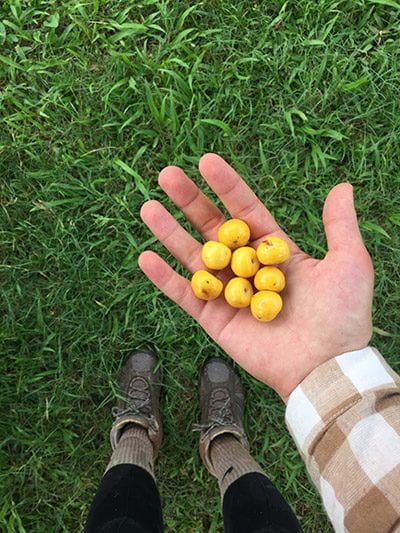
Craboo fruits.
Three local guides were also indispensable, helping the women with practical advice like how to identify animal tracks, and which foods to use to attract animals to their traps (mammee apples, mango slices, and cat food work better than peanut butter or mango jelly). At first it was startling for Johnson and Redding to discover just how much they didn’t know: “We had been researching before we left for Belize, but we knew nothing,” Redding reflects. “We had the scientific names and information but no real experience with these exotic animals. It was interesting being an ‘expert’ in someone else’s community, because they know so much more than you do.”
“It takes both sides,” Johnson added. “You can’t just go abroad and expect to help a community, because they’re also going to help you. It’s a collaborative process.” This cooperative spirit helped the women make strong connections with the community, both in the park and in their more urban home base of Dangriga. Tanisha Cacho, the pair’s Peaceworks community liaison, became like a Belizean mother to them, looking out for their wellbeing and teaching them to make traditional dishes like the fish-based hudut.
Johnson and Redding found it difficult to leave their Belizean family, but they were able to offer a parting gift: the students donated a live trap and game camera to the park, in the hopes that others will be able to continue their research. The park will also use the information and pictures gathered by the pair to apply for grants and increase tourism in the area. As for Johnson and Redding, they are submitting a paper about their experience to the International Undergraduate Journal for Service-learning, Leadership and Social Change, in the hopes that others will be motivated by their story.
Johnson and Redding helped to pilot the Honors College Extended Research Travel Grant, now an annual grant program with a fall deadline.
More Field Notes Stories
Reading Renaissance Portraits
Clio Rom links Petrarch’s poetry with static, idealized profile portraits. Neoplatonic philosopher Marsilio Ficino, who believed that looking into a woman’s eyes could inspire a divine frenzy, may have prompted the shift to three-quarter views. Here, Rom walks us through three portraits that signify a sea change in Renaissance art, literature and philosophy.
Civil War Meets Mid-Century Modern
Built in 1956 as part of the “Mission 66” federal initiative to modernize national parks, the overlook at Pea Ridge Military Park affords stunning views of a battlefield where the Union army won a decisive victory over Confederate forces. But the mid-century modern structure, still pleasing to 21st-century tastes, landed on a historically sensitive site.
Hydroponic Profits
Honors students Sarah Gould and Laura Gray stand between two wooden stakes embedded in the ground at local community garden Tri Cycle Farms. Today the empty space holds a vision: a greenhouse for hydroponically grown vegetables that will generate profits, and a sustainable future, for the farm. Gould and Gray’s honors theses in biological engineering will help transform this vision into reality.
A Champion for Cultural Competency
Marshall Islanders have moved from a culture where the sick consult healers and pastors into health care marked by waiting rooms, co-pays, and often complicated jargon. Many people in Northwest Arkansas pass them in the grocery store, at a bus stop, or in a doctor’s office, but never truly understand who they are and where they have come from.
Market Entry Masala
Nine cities. 14 days. 23 meetings. It’s an eye-popping schedule, but for accounting and finance major Grayson Greer, it was a bold way to jump-start research on his honors thesis. He designed the two-week trip to India himself, intent on identifying a unified strategy for entering the Indian food and beverage market.

Mersady Redding with a big-eared climbing rat caught in a live trap.

The Natural Resource Center at Billy Barquedier National Park.

Kelsey Johnson on a barracuda fishing excursion to Tobacco Caye.


